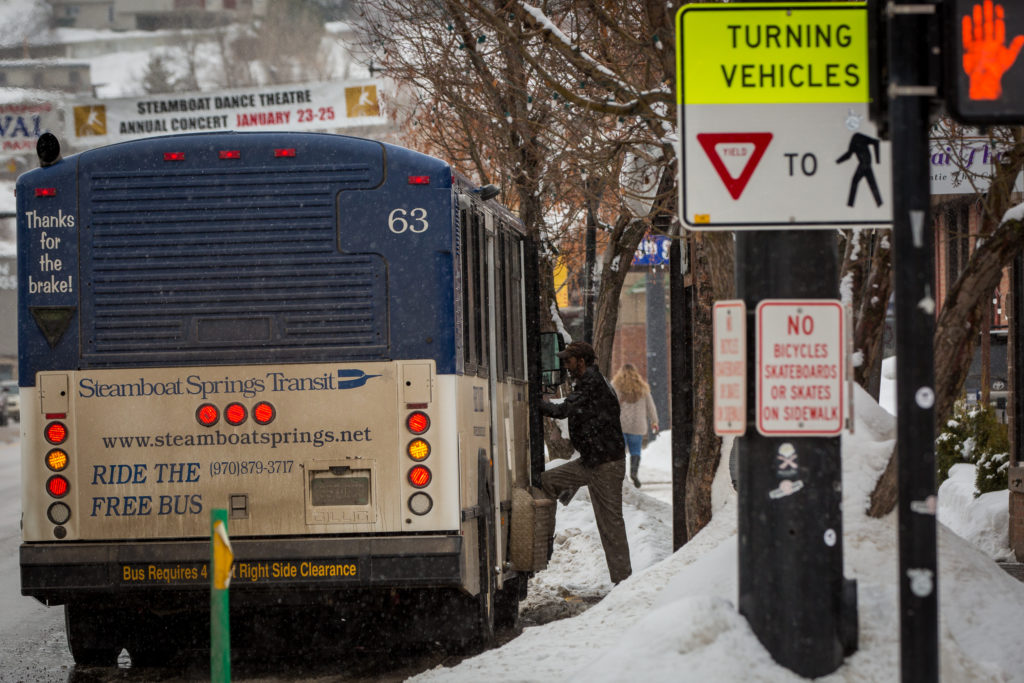Public transit could expand in northwestern Colorado. First, it’s up to voters – Colorado Public Radio

Yampa Valley Regional Transportation Authority Proposal
Introduction
A ballot measure in northwestern Colorado proposes the establishment of the Yampa Valley Regional Transportation Authority (RTA). Voters in Yampa, Steamboat Springs, Hayden, Oak Creek, Craig, and unincorporated Routt County will decide on the formation of this intergovernmental entity. The RTA is designed to plan, finance, and operate a regional transit system, directly addressing several key United Nations Sustainable Development Goals (SDGs).
Alignment with Sustainable Development Goals (SDGs)
SDG 11: Sustainable Cities and Communities & SDG 9: Industry, Innovation, and Infrastructure
The primary objective of the proposed RTA is to create a safe, affordable, accessible, and sustainable transport system for all, in direct alignment with SDG 11.2. By expanding transit options, the initiative aims to build resilient infrastructure (SDG 9) that supports economic development and human well-being for both the regional workforce and visitors. Potential infrastructure and service enhancements include:
- Expansion of bus services and routes.
- New transportation options to and from the regional airport.
- Road improvements to enhance safety and efficiency.
- Introduction of micro-mobility solutions such as e-bikes and electric scooters.
- Development of park-and-ride facilities to integrate personal and public transport.
SDG 13: Climate Action & SDG 15: Life on Land
A significant driver for the RTA is environmental stewardship. Proponents emphasize that expanding public transit is a critical climate action (SDG 13) aimed at reducing regional carbon emissions from private vehicles. Furthermore, the plan includes provisions for wildlife crossings, a direct measure to protect terrestrial ecosystems and halt biodiversity loss (SDG 15) by reducing vehicle-wildlife collisions.
SDG 8: Decent Work and Economic Growth
The RTA is positioned to support decent work and economic growth (SDG 8) by addressing the transportation needs of the local workforce. By providing reliable and efficient transit, the authority would reduce commute times and stress for individuals traveling across city and county lines, thereby improving quality of life and facilitating access to employment opportunities.
Governance and Financial Framework
Phased Financial Strategy and Partnerships (SDG 17)
The RTA’s formation exemplifies a multi-stakeholder partnership for sustainable development (SDG 17). The initial ballot measure seeks only to establish the authority, not to levy new taxes. Foundational funding includes a commitment from the Steamboat Ski and Resort Corporation of $1 million annually for a minimum of three years. Under state law, the RTA has several potential long-term revenue options:
- Collection of fares for services or tolls for road use.
- Pursuit of state and federal loans and grants.
- Imposition of a small annual vehicle registration fee.
- Levying of taxes, which would require separate future voter approval.
While there is no organized opposition, concerns have been noted regarding the potential for future tax or bond measures.
Implementation Conditions
The intergovernmental agreement allows for a flexible implementation path. The Yampa Valley RTA can be formed provided the measure passes in the jurisdiction of Steamboat Springs and at least one other participating community.
Analysis of Sustainable Development Goals in the Article
1. Which SDGs are addressed or connected to the issues highlighted in the article?
- SDG 9: Industry, Innovation and Infrastructure: The article’s central theme is the establishment of the Yampa Valley Regional Transportation Authority to “oversee, plan, finance and operate a regional transit system.” This directly involves building resilient and sustainable infrastructure to support economic development and well-being.
- SDG 11: Sustainable Cities and Communities: The initiative aims to provide “adequate transportation and transit systems” for communities in northwestern Colorado. By offering more transit options like buses, e-bikes, and scooters, the plan seeks to create safer, more accessible, and sustainable transportation systems for residents and visitors.
- SDG 13: Climate Action: A key motivation for the new transportation authority is climate change mitigation. The article explicitly quotes a proponent saying, “It’s climate action,” and notes that expanding transit options can “help reduce emissions” by making it easier for people not to drive.
- SDG 15: Life on Land: The article mentions that potential projects for the transportation authority could include “adding more wildlife crossings.” This directly addresses the need to protect terrestrial ecosystems and biodiversity from the impacts of human infrastructure like roads.
2. What specific targets under those SDGs can be identified based on the article’s content?
- Target 9.1: Develop quality, reliable, sustainable and resilient infrastructure, including regional and transborder infrastructure, to support economic development and human well-being, with a focus on affordable and equitable access for all. The entire proposal to create the Yampa Valley Regional Transportation Authority to build and operate a “regional transit system” across multiple towns and counties aligns with this target.
- Target 11.2: By 2030, provide access to safe, affordable, accessible and sustainable transport systems for all, improving road safety. The article details plans for “more buses and routes, new options to get to and from the local airport, road improvements,” and alternative transport like “electric scooters, e-bikes” to serve the workforce and visitors, which directly supports this target. The mention of “safety” as a benefit also connects to this goal.
- Target 13.2: Integrate climate change measures into national policies, strategies and planning. The establishment of a regional authority with a stated goal of reducing emissions through improved public transit is a form of integrating climate action into regional planning and strategy.
- Target 15.5: Take urgent and significant action to reduce the degradation of natural habitats, halt the loss of biodiversity and, by 2020, protect and prevent the extinction of threatened species. The specific mention of “adding more wildlife crossings” is a direct action aimed at mitigating the impact of roads on local wildlife and their habitats, thus contributing to this target.
3. Are there any indicators mentioned or implied in the article that can be used to measure progress towards the identified targets?
- Implied Indicator for Target 11.2 (Indicator 11.2.1): The article implies the measurement of the proportion of the population with convenient access to public transport. The creation of the RTA to serve Yampa, Steamboat Springs, Hayden, Oak Creek, Craig, and Routt County is the first step. Progress would be measured by the expansion of “more buses and routes” and the introduction of new services, thereby increasing the number of people served.
- Implied Indicator for Target 13.2: A key implied indicator is the reduction of greenhouse gas emissions from the transportation sector in the Yampa Valley region. The article states that a goal is to “reduce emissions” by providing alternatives that “make it easier for somebody to not have to drive.” Progress could be measured by tracking vehicle miles traveled (VMT) per capita or shifts in transportation mode from single-occupancy vehicles to public transit, e-bikes, and scooters.
- Mentioned Indicator for Target 15.5: The article explicitly mentions a potential project: “adding more wildlife crossings.” The number of new wildlife crossings constructed would be a direct and measurable indicator of progress toward protecting local ecosystems from transportation infrastructure.
- Mentioned Indicator for Target 9.1: The primary indicator is the successful establishment of the Yampa Valley Regional Transportation Authority itself. Further progress would be measured by the amount of investment in transportation infrastructure, such as the “$1 million annually” from the Steamboat Ski and Resort Corporation, and the implementation of planned projects like “road improvements” and “park and rides.”
4. Table of SDGs, Targets, and Indicators
| SDGs | Targets | Indicators (Mentioned or Implied in the Article) |
|---|---|---|
| SDG 9: Industry, Innovation and Infrastructure | 9.1: Develop quality, reliable, sustainable and resilient infrastructure, including regional infrastructure. | The establishment of the Yampa Valley Regional Transportation Authority; implementation of road improvements and park and rides; investment amounts (e.g., $1 million annually). |
| SDG 11: Sustainable Cities and Communities | 11.2: Provide access to safe, affordable, accessible and sustainable transport systems for all. | Expansion of service coverage (“more buses and routes”) to serve the population of the member communities; introduction of new transport options (e-bikes, scooters). |
| SDG 13: Climate Action | 13.2: Integrate climate change measures into policies, strategies and planning. | Reduction in transportation-related emissions; shift in commuter patterns from private cars to public transit. |
| SDG 15: Life on Land | 15.5: Take urgent and significant action to reduce the degradation of natural habitats and halt the loss of biodiversity. | The number of new wildlife crossings constructed. |
Source: cpr.org
What is Your Reaction?
 Like
0
Like
0
 Dislike
0
Dislike
0
 Love
0
Love
0
 Funny
0
Funny
0
 Angry
0
Angry
0
 Sad
0
Sad
0
 Wow
0
Wow
0














































.jpg.webp?itok=0ZsAnae9#)







:focal(1500,1000)/https://media.globalcitizen.org/a6/9a/a69a4720-d8a1-4715-b596-18738d03c05c/rotary_polio_hero_image.jpg?#)

/countries/sri-lanka/photo-credit---dmc-sri-lanka.tmb-1200v.jpg?sfvrsn=dc298bcc_1#)


















